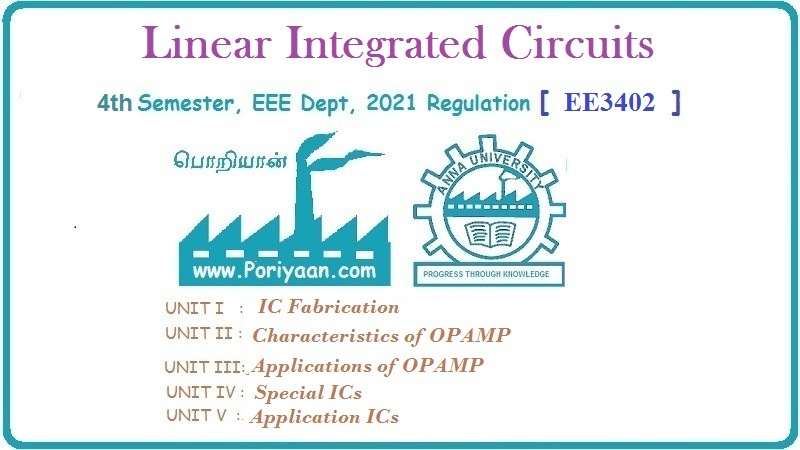Linear Integrated Circuits: Unit II: Characteristics of Op-amp
Internal Compensation Technique used in operational amplifiers
Miller Effect Compensation | Op-amp
A capacitor ranging from 10 to 30 pF is fabricated between input and output stage to achieve the necessary compensation. This type of compensation is called Miller effect compensation. Such op-amps are called compensated op-amps.
Internal Compensation Technique
Recently
in op-amps like IC 741, the compensation is provided internally, which is
generally built in lag compensation.
A
capacitor ranging from 10 to 30 pF is fabricated between input and output stage
to achieve the necessary compensation. This type of compensation is called
Miller effect compensation. Such op-amps are called compensated op-amps.
1. Miller Effect Compensation
The
main drawback of dominant pole compensation is the reduction in the bandwidth.
Similarly the value of capacitance required in this method is very large and
fabricating such large capacitance on the chip is not practicable.
These
drawbacks are avoided by using Miller effect compensation, using the Miller
effect. In dominant pole compensation, a capacitor is connected to ground from
the output terminal but in Miller effect compensation it is connected in the
feedback path of the Darlington pair used in the output stage of op-amp. This
is shown in the Fig. 2.34.1.

The
Cc is the compensating capacitor, Ri is the input
resistance and Ro is the output resistance of the Darlington stage.
The gain of the Darlington stage is given by,
a2
= - Gmc Ro
Where
Gmc = Transconductance of the stage
Looking
through the input terminal Cc appears as the Miller capacitance CM
and from the results of Miller effect we can write,

Thus
effectively Cc gets multiplied by (1 + a2) where a2
is the gain of the stage which is large, as viewed through the input terminals.
Thus practically small Cc values can be used, which is helpful from
monolithic fabrication point of view.
This
Miller equivalent capacitance CM forms a low pass RC section with
input resistance Ri whose comer frequency is given by,
fd
= 1/ 2πCMRi ...
(2.34.1)
The
uncompensated and compensated magnitude plots are shown in the Fig. 2.34.2.

In
addition to the multiplying the capacitance, Miller effect has another
advantage. It causes rearrangement of original poles and cause Pole splitting.
This means due to Miller effect compensation, f1 gets lowered while f2 gets
raised. Thus poles get diverged. This increases the bandwidth compared to
dominant pole compensation.
Key
Point The Miller effect compensation is simplest and
most commonly used for internally compensated op-amps.
Such
compensated op-amps usually have single break frequency and are inherently
stable in nature irrespective of value of closed loop gain. External
compensating network is not required for such op-amps.
Some
internally compensated op-amps are Fairchild's µA 741, National semiconductor's
LM 107, LM 741, LM 112 and Motorola's MC 1858.
Review Question
1. Write a note on
Miller effect compensation.
Linear Integrated Circuits: Unit II: Characteristics of Op-amp : Tag: : Miller Effect Compensation | Op-amp - Internal Compensation Technique used in operational amplifiers
Related Topics
Related Subjects
Linear Integrated Circuits
EE3402 Lic Operational Amplifiers 4th Semester EEE Dept | 2021 Regulation | 4th Semester EEE Dept 2021 Regulation
